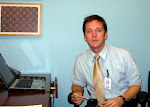
I remember my first needle stick well. I was working in Baragwanath Hospital in Soweto, outside of Johannesburg, South Africa. It was 2003. Essentially all of the children in the ward where I worked were HIV positive, and one of my duties was to draw blood from them.
When it happened, I was using a needle to puncture the seal of the IV bag to draw out some saline solution for an IV. Instead, the misguided needle entered the index finger of my left hand.
I remember the incident vividly. I remember wondering why there was so much resistance as I tried to advance the needle into the IV bag. I remember looking down to see that the needle was in the correct position, and then I remember the sharp sting. I looked down, hoping that I did not see blood. When my eyes made it down to my latex glove, there was a growing wine-colored splotch where I had hoped to see uninterrupted powdery white.
I tore off the glove to confirm that the splotch was actually blood, and it was. I darted to the sink and rinsed the finger, looking carefully at the entry point, trying to see how deep is was.
I then paused and sighed with relief.
The needle, I reminded myself, was clean and unused (at least until its tip was covered with my blood) and thus the accident was no more dangerous than a stubbed toe, and probably less painful.
--
Andrew is a young PICU nurse working here in Swaziland. Prior to moving to Swaziland, he worked in the pediatric intensive care unit of NYC’s Bellview Hospital. Now, he works in the Baylor clinic, where his primary duty is to draw blood from those patients needing laboratory evaluations. He takes blood from dozens of patients a day. He is very good at his job.
The problem with phlebotomy in a pediatric HIV ward is threefold: If the children are well enough to fight, they usually do. If they are without strength, their blood vessels are often also weak, fragile. The room set aside for pediatric procedures is inevitably small and crowded with at least three people (child, parent, nurse) and with whatever else is being stored there.
After a few thousand blood draws over the past 6 months, Andrew was removing a needle from the arm of a four-week old baby who had been exposed to HIV during birth and early breastfeeding.
As he was doing so, the baby jerked and the needle entered the index finger of his right hand. The needle made it through the glove and skin, and brought an HIV exposed infant’s blood with it.
“At first I didn’t think that I had done it.” Andrew told me during a recent conversation. When he took off his glove and saw blood, he realized that he had.
“All I could think was that I wanted to rinse off my hand but also I needed to transfer the blood I had drawn so it did not clot, because then I would have to redraw it.”
Andrew transferred the blood, rinsed his finger and, later that day, started post-exposure prophylaxis, a three-drug antiretroviral regimen similar to that taken by HIV positive adults.
“I can tell that there is something in my body that is not supposed to be there,” Andrew said one morning as we met for our morning jog. He had taken his ARVs a few minutes prior. He looked a bit green.
“I’m tired,” he admitted three miles into our four-mile circuit. (I was too, but I had no excuse, except perhaps my being a bit older.)
I recently asked Andrew about the medication's side effects.
“The worst is a low-grade nausea and a metallic taste at the back of your mouth…But, after a while you just get used to it.”
"Now I know what the patients go through," he told me.
I asked Andrew how it was to tell his family about the incident. “Difficult,” he responded. “I handle blood all day every day, blood that has HIV in it...HIV is the norm here. In the US, it is not.”
Fortunately, Andrew explained to me, only three people in a thousand convert to positive after being stuck with a HIV contaminated, hollow bore needle. This risk decreases by eighty percent if post-exposure prophylaxis is taken, a reduction that justifies the untoward side effects.
After two weeks on ARVs, Andrew saw the baby again in clinic. He sent the now 6 week-old’s blood for a special evaluation not yet commonly available in Swaziland, a blood test called HIV DNA PCR. It detects the HIV virus directly, and would determine whether the child had been infected with his mother’s HIV earlier than the more commonly used antibody tests, which are only accurate after 18 months of age.
A few days later, I heard a knock on my exam room door. “Yes?”
Andrew burst into my exam room.
“Negative.” He said. His facial expression was one of relief.
Andrew stopped the meds just in time for our weekend mountain biking excursion in the mountains of South Africa (see entry below). The fatigue, nausea, and metallic taste faded.
Andrew continues to draw blood several dozen times a day, blood that has HIV in it, blood that guides all medical decisions made in our clinic. He seldom misses, no matter how combative the child, no matter how fragile the vein.
As you can see from the link below (a brief mountain biking video clip), he is no longer so tired.
Link: Andrew's mountain biking video clip (11 Feb 2007).























